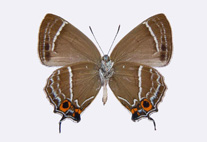Abstract
Among the acanthocephalans, Neoechinorhynchus is one of the most speciose genera, with 116 described species distributed worldwide. The adults of Neoechinorhynchus are found in the intestine of freshwater and brackish water fish, as well as in freshwater turtles. In this study, a checklist of the congeneric species of Neoechinorhynchus occurring in Middle-American fish and turtles is presented. The checklist contains the records established in all published accounts, as well as novel data from survey work conducted in the region comprising Neotropical areas of Mexico, as well as some localities in Central America. The species delimitation criteria used to discriminate among species is based on molecular data. In the last years, a large database derived from sequences of the D2 + D3 domains of the large subunit of rDNA (28S) was generated for 262 specimens corresponding to nine species of Neoechinorhynchus. This molecular marker has shown to be useful in establishing species limits within Neoechinorhynchus and in resolving phylogenetic relationships at species level. Based on our results, the domains D2 + D3 of the 28S rDNA could be considered as potential DNA barcodes to complement mitochondrial DNA to discriminate among acanthocephalan species.

